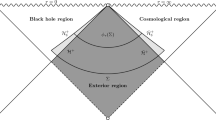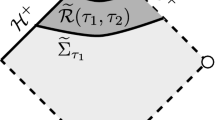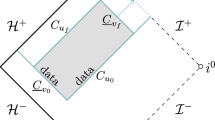Abstract
We consider solutions to the massless Vlasov equation on the domain of outer communications of the Schwarschild black hole. By adapting the \(r^p\)-weighted energy method of Dafermos and Rodnianski, used extensively in order to study wave equations, we prove superpolynomial decay for a non-degenerate energy flux of the Vlasov field f through a well-chosen foliation. An essential step of this methodology consists in proving a non-degenerate integrated local energy decay. For this, we take in particular advantage of the redshift effect near the event horizon. The trapping at the photon sphere requires, however, to lose an \(\epsilon \) of integrability in the velocity variable. Pointwise decay estimates on the velocity average of f are then obtained by functional inequalities, adapted to the study of Vlasov fields, which allow us to deal with the lack of a conservation law for the radial derivative.





Similar content being viewed by others
Notes
This means that \(\textrm{d}\mu _{{\mathcal {R}}_{-\infty }^{+\infty }}=-g\big (n^{}_{\Sigma _{\tau }}, \cdot \big ) \wedge \textrm{d}\mu ^{}_{\Sigma _{\tau }}\).
This formula holds in a more general setting (see [19]).
In the context of wave equations, this quantity is often denoted by \(J^{\textrm{N}}[f] \cdot n^{}_{\Sigma _{\tau }}\), where \(J^{\textrm{N}}[f]_{\mu }:= {\mathbb {T}}[f]_{\mu \nu } \textrm{N}^{\nu }\).
In other words, near the event horizon, the velocity current v should then rather be decomposed as \( v = v_{{\underline{u}}}' \textrm{d}{\underline{u}}+ v_r' \textrm{d}r+v_{\theta } \textrm{d}\theta +v_{\varphi } \textrm{d}\varphi \), where, in particular \(\frac{2v_u}{1-\frac{2M}{r}}= v_r'\).
This property is of course not satisfied for any \(L^1({\mathbb {R}}^3)\)-function but this is an heuristic discussion.
Note that there exist constants \(C_{\epsilon }\) such that, in the sense of the distributions, \(C_{\epsilon }h_{\epsilon }(t_0,\cdot ) \rightarrow _{\epsilon \rightarrow 0} F(t_0)\).
When applied to the time derivative of the solution, one can in fact extend the method to the range \(0 \le p < 4\) (see [36, Section 5C]).
Note that there is no boundary terms since \(\{v_{r^*}=0\}\) has Lebesgue measure 0.
References
Andersson, L., Blue, P.: Hidden symmetries and decay for the wave equation on the Kerr spacetime. Ann. Math. (2) 182(3), 787–853 (2015)
Andersson, L., Blue, P., Joudioux, J.: Hidden symmetries and decay for the Vlasov equation on the Kerr spacetime. Commun. Partial Differ. Equ. 43(1), 47–65 (2018)
Andersson, L., Bäckdahl, T., Blue, P., Ma, S.: Stability for linearized gravity on the Kerr spacetime. arXiv:1903.03859 (2019)
Angelopoulos, Y., Aretakis, S., Gajic, D.: Late-time asymptotics for the wave equation on spherically symmetric, stationary spacetimes. Adv. Math. 323, 529–621 (2018)
Angelopoulos, Y., Aretakis, S., Gajic, D.: A vector field approach to almost-sharp decay for the wave equation on spherically symmetric, stationary spacetimes. Ann. PDE 4(2), 1–120 (2018)
Aretakis, S.: Stability and instability of extreme Reissner–Nordström black hole spacetimes for linear scalar perturbations I. Commun. Math. Phys. 307(1), 17–63 (2011)
Aretakis, S.: Stability and instability of extreme Reissner–Nordström black hole spacetimes for linear scalar perturbations II. Ann. Henri Poincaré 12(8), 1491–1538 (2011)
Bigorgne, L.: A vector field method for massless relativistic transport equations and applications. J. Funct. Anal. 278(4), 108365 (2020)
Bigorgne, L., Fajman, D., Joudioux, J., Smulevici, J., Thaller, M.: Asymptotic stability of Minkowski space-time with non-compactly supported massless Vlasov matter. Arch. Ration. Mech. Anal. 242(1), 1–147 (2021)
Blue, P., Soffer, A.: Phase space analysis on some black hole manifolds. J. Funct. Anal. 256(1), 1–90 (2009)
Blue, P., Sterbenz, J.: Uniform decay of local energy and the semi-linear wave equation on Schwarzschild space. Commun. Math. Phys. 268(2), 481–504 (2006)
Christodoulou, D., Klainerman, S.: The Global Nonlinear Stability of the Minkowski Space. Princeton Mathematical Series, vol. 41. Princeton University Press, Princeton (1993)
Dafermos, M., Holzegel, G., Rodnianski, I.: Boundedness and decay for the Teukolsky equation on Kerr spacetimes I: the case \(|a|\ll M\). Ann. PDE 5(1), 1–118 (2019)
Dafermos, M., Holzegel, G., Rodnianski, I.: The linear stability of the Schwarzschild solution to gravitational perturbations. Acta Math. 222(1), 1–214 (2019)
Dafermos, M., Rodnianski, I.: The red-shift effect and radiation decay on black hole spacetimes. Commun. Pure Appl. Math. 62(7), 859–919 (2009)
Dafermos, M., Rodnianski, I.: A new physical-space approach to decay for the wave equation with applications to black hole spacetimes. In: XVIth International Congress on Mathematical Physics, pp. 421–432. World Scientific Publications, Hackensack (2010)
Dafermos, M., Rodnianski, I.: Lectures on black holes and linear waves. In: Evolution Equations Clay Mathematical Proceedings, vol. 17, pp. 97–205. American Mathematical Society, Providence (2013)
Dafermos, M., Rodnianski, I., Shlapentokh-Rothman, Y.: Decay for solutions of the wave equation on Kerr exterior spacetimes III: the full subextremal case \(|a|<M\). Ann. Math. (2) 183(3), 787–913 (2016)
Fajman, D., Joudioux, J., Smulevici, J.: The stability of the Minkowski space for the Einstein-Vlasov system. Anal. PDE, 14(2), 425–531 (2021)
Fajman, D., Joudioux, J., Smulevici, J.: A vector field method for relativistic transport equations with applications. Anal. PDE 10(7), 1539–1612 (2017)
Giorgi, E.: Boundedness and decay for the Teukolsky equation of spin \(\pm 1\) on Reissner–Nordström spacetime: the \(\ell =1\) spherical mode. Class. Quantum Gravity 36(20), 205001 (2019)
Johnson, T.W.: The linear stability of the Schwarzschild solution to gravitational perturbations in the generalised wave gauge. Ann. PDE, 5(2), 92 (2019)
Keir, J.: The weak null condition and global existence using the p-weighted energy method. arXiv:1808.09982 (2018)
Klainerman, S.: Uniform decay estimates and the Lorentz invariance of the classical wave equation. Commun. Pure Appl. Math. 38(3), 321–332 (1985)
Klainerman, S., Szeftel, J.: Global nonlinear stability of Schwarzschild spacetime under polarized perturbations, volume 210 of Annals of Mathematics Studies. Princeton University Press, Princeton, NJ (2020)
Lindblad, H., Rodnianski, I.: The global stability of Minkowski space-time in harmonic gauge. Ann. Math. (2) 171(3), 1401–1477 (2010)
Lindblad, H., Taylor, M.: Global stability of Minkowski space for the Einstein–Vlasov system in the harmonic gauge. Arch. Ration. Mech. Anal. 235(1), 517–633 (2020)
Luk, J.: Improved decay for solutions to the linear wave equation on a Schwarzschild black hole. Ann. Henri Poincaré 11(5), 805–880 (2010)
Luk, J.: A vector field method approach to improved decay for solutions to the wave equation on a slowly rotating Kerr black hole. Anal. PDE 5(3), 553–625 (2012)
Moschidis, G.: The \(r^p\)-weighted energy method of Dafermos and Rodnianski in general asymptotically flat spacetimes and applications. Ann. PDE 2(1), 1–194 (2016)
Pasqualotto, F.: Nonlinear stability for the Maxwell–Born–Infeld system on a Schwarzschild background. Ann. PDE 5(2), 19 (2019)
Pasqualotto, F.: The spin \(\pm 1\) Teukolsky equations and the Maxwell system on Schwarzschild. Ann. Henri Poincaré 20(4), 1263–1323 (2019)
Rioseco, P., Sarbach, O.: Accretion of a relativistic, collisionless kinetic gas into a Schwarzschild black hole. Class. Quantum Gravity 34(9), 095007 (2017)
Sarbach, O., Zannias, T.: The geometry of the tangent bundle and the relativistic kinetic theory of gases. Class. Quantum Gravity 31(8), 085013 (2014)
Sbierski, J.: Characterisation of the energy of Gaussian beams on Lorentzian manifolds: with applications to black hole spacetimes. Anal. PDE 8(6), 1379–1420 (2015)
Schlue, V.: Decay of linear waves on higher-dimensional Schwarzschild black holes. Anal. PDE 6(3), 515–600 (2013)
Taylor, M.: The global nonlinear stability of Minkowski space for the massless Einstein–Vlasov system. Ann. PDE 3(1), 9 (2017)
Yang, S.: Global solutions of nonlinear wave equations in time dependent inhomogeneous media. Arch. Ration. Mech. Anal. 209(2), 683–728 (2013)
Yang, S.: Global solutions of nonlinear wave equations with large data. Selecta Math. (N.S.) 21(4), 1405–1427 (2015)
Yang, S.: Decay of solutions of Maxwell–Klein–Gordon equations with arbitrary Maxwell field. Anal. PDE 9(8), 1829–1902 (2016)
Yang, S.: On the global behavior of solutions of the Maxwell–Klein–Gordon equations. Adv. Math. 326, 490–520 (2018)
Yang, S.: Pointwise decay for semilinear wave equations in \({\mathbb{R}}^{3+1}\). J. Funct. Anal., 283(2), 59 (2022)
Yang, S., Yu, P.: On global dynamics of the Maxwell–Klein–Gordon equations. Camb. J. Math. 7(4), 365–467 (2019)
Acknowledgements
I would like to thank Dejan Gajic and Mihalis Dafermos for insightful discussions. This material is based upon work supported by the Swedish Research Council under Grant No. 2016-06596 while I was in residence at Institut Mittag-Leffler in Djursholm, Sweden, during the fall semester 2019. I also acknowledge the support of partial funding by the ERC Grant MAFRAN 2017-2022.
Funding
European Research Council
Author information
Authors and Affiliations
Corresponding author
Additional information
Communicated by Mihalis Dafermos.
Publisher's Note
Springer Nature remains neutral with regard to jurisdictional claims in published maps and institutional affiliations.
Appendices
Basic Properties of the Foliation \((\Sigma _{\tau })_{\tau \in {\mathbb {R}}}\)
The purpose of this section is to prove Lemma 1.4. As the Regge–Wheeler coordinates degenerate at the horizon, it will be convenient to use the coordinate system \(({\underline{u}}, r, \theta , \varphi ) \in {\mathbb {R}}\times {\mathbb {R}}_+^* \times ]0,\pi [ \times ]0,2 \pi [\), which covers the region \({\mathscr {B}} \cup {\mathcal {H}}^+ \cup {\mathscr {D}}\) (see Fig. 1) and which is then regular on the event horizon \({\mathcal {H}}^+\), where \(r=2M\). Recall that the metric takes the following form
and that, denoting by \(\partial _{{\underline{u}}}'\) and \(\partial _{r}'\) the differentiation with respect to \({\underline{u}}\) and r in the coordinate system \(({\underline{u}}, r, \theta , \varphi )\), we have in \({\mathscr {D}}\),
In particular, \( \frac{ 1}{1-\frac{2M}{r}} \partial _u\) can be extended as a smooth vector field on \({\mathscr {B}} \cup {\mathcal {H}}^+ \cup {\mathscr {D}}\). The invariant volume element \(\textrm{d}\mu ^{}_{{\mathcal {M}}}\) induced by g on \({\mathcal {M}}\) can be expressed, in the region \({\mathcal {R}}_{-\infty }^{+\infty } \subset {\mathscr {D}}\), in the following three different ways
where \( \textrm{d}\mu ^{}_{{\mathbb {S}}^2}\) is the standard volume form on the unit sphere \({\mathbb {S}}^2\). As the hypersurfaces \({\mathcal {N}}_{\tau }\) are null, there is no canonical choice of normal vector \(n^{}_{{\mathcal {N}}_{\tau }}\). Since
we choose \(n^{}_{{\mathcal {N}}_{\tau }}:=\partial _{{\underline{u}}}\) and the induced volume form on \({\mathcal {N}}_{\tau }\) is \(\textrm{d}\mu ^{}_{{\mathcal {N}}_{\tau }}:= r^2 \textrm{d}{\underline{u}}\wedge \textrm{d}\mu ^{}_{{\mathbb {S}}^2}\). As \(\tau =u-u_0\) for \(r \ge R_0\) and \(\Sigma _{\tau } \cap \{ r\ge R_0 \} ={\mathcal {N}}_{\tau }\), we have, for all \( r \ge R_0\),
We have then obtained all the results of Lemma 1.4 which concern the region \(r \ge R_0\) and we now focus on the domain \(2\,M< r < R_0\), where \(\Sigma _{\tau }\) is spacelike. We start by proving the following result.
Lemma A.1
There exists a smooth function \({\underline{U}}: [2\,M, R_0 ] \rightarrow {\mathbb {R}}\) such that, for any \(\tau \ge 0\), \(\Sigma _{\tau } \cap \{ r < R_0 \}\) can be parameterized, in the system of coordinates \(({\underline{u}},r,\theta , \varphi )\), by
Moreover, the vector field \(\textbf{n}:= g^{-1} ( \textrm{d}{\underline{u}}- {\underline{U}}'(r) \textrm{d}r, \cdot )\) is normal to \(\Sigma _{\tau } \cap \{ r < R_0 \}\) and timelike in the region \(\{ 2\,M \le r \le R_0 \}\).
Proof
It will be convenient to work here with the coordinate system \(({\underline{u}},r,\theta , \varphi )\). Since \(\Sigma _{\tau } \cap \{ r< R_0 \} = \varphi _{\tau } \left( \Sigma _{0} \cap \{ r < R_0 \} \right) \), where \(\varphi _{\tau }\) is the flow generated by the Killing vector field \(\partial _t=\partial _{{\underline{u}}}'\), it suffices to prove the result for \(\tau =0\). Then, recall that by construction,  , where
, where  is a spacelike hypersurface crossing \({\mathcal {H}}^+\) to the future of the bifurcation sphere. Hence, there exists \(\delta < 0\) such that
is a spacelike hypersurface crossing \({\mathcal {H}}^+\) to the future of the bifurcation sphere. Hence, there exists \(\delta < 0\) such that  . As \(\widetilde{{\mathcal {S}}}\) is a smooth spherically symmetric hypersurface, for any \(x \in \widetilde{{\mathcal {S}}}\), there exist an open set O containing x and a smooth function \(F_O\) such that
. As \(\widetilde{{\mathcal {S}}}\) is a smooth spherically symmetric hypersurface, for any \(x \in \widetilde{{\mathcal {S}}}\), there exist an open set O containing x and a smooth function \(F_O\) such that
Since \(\widetilde{{\mathcal {S}}}\) is spacelike, \(\partial _t=\partial _{{\underline{u}}}' \notin T_x \widetilde{{\mathcal {S}}}\) for any x in the region \(r \ge 2\,M\), so that \(\partial '_{{\underline{u}}} F_O\) does not vanish on \(\widetilde{{\mathcal {S}}} \cap O \cap \{ r \ge 2M \}\). According to the implicit function theorem, we obtain that for any \(x \in \widetilde{{\mathcal {S}}} \cap \{ r \ge 2\,M \}\), there exist an open set \(O'\) containing x and a smooth function \({\underline{U}}_{O'}\) such that
By a connexity argument, this implies, if \(\delta >0\) is chosen small enough, that there exists a smooth function \({\underline{U}}: \, ]2\,M-\delta ,+\infty [ \rightarrow {\mathbb {R}}\) such that
We then deduce that the 1-form \(\textrm{d}{\underline{u}}- {\underline{U}}'(r) \textrm{d}r\) is normal to the spacelike hypersurface \(\widetilde{{\mathcal {S}}}\). This implies that the \(\varphi _{\tau }\)-invariant vector field \(\textbf{n}\) is normal to \(\Sigma _{\tau } \cap \{ r^* < R_0^* \}\) and timelike on \({\mathcal {H}}^+ \cup {\mathscr {D}}\). \(\square \)
As we have \(t={\underline{u}} -r^*\) in the region \({\mathscr {D}}\), this implies that the parameterization of \(\Sigma _{\tau } \cap \{ r < R_0 \}\) in the Regge–Wheeler coordinates given in Lemma 1.4 holds. In order to prove the remaining four properties, notice first that, as \(\textbf{n}\) is \(\varphi _{\tau }\)-invariant, \(SO_3({\mathbb {R}})\)-invariant and timelike on \(\{ 2M \le r \le R_0 \}\), we can define the smooth function
Note now that the future oriented normal vector along \(\Sigma _{\tau } \cap \{ r < R_0\}\) is equal either to \(\frac{\textbf{n}}{\gamma (r)}\) or to \(-\frac{\textbf{n}}{\gamma (r)}\). So, as the induced volume form on \(\Sigma _{\tau }\) satisfies
Since \( \tau = \underline{u} -\underline{U}(r)\) for \(2M< r < R_0\), we have, for all \(2M< r < R_0\),
Finally, in view of the properties of \(\textbf{n}\), there exist smooth functions \(\xi , \, \zeta :[2M,R_0] \rightarrow {\mathbb {R}}\) such that \(n^{}_{\Sigma _{\tau }}= \xi (r)\partial _{{\underline{u}}}'+\zeta (r) \partial _r'\). We then deduce from (50) that there exist smooth functions \(\alpha , \, \beta :[2M,R_0] \rightarrow {\mathbb {R}}\) satisfying \(n^{}_{\Sigma _{\tau }}= \alpha (r)\partial _{{\underline{u}}}+\frac{\beta (r)}{1-\frac{2\,M}{r}} \partial _u\). As \(n^{}_{\Sigma _{\tau }}\) is unitary and timelike, we have using (4) that \(\alpha (r) \beta (r)=1\) for all \(2\,M< r < R_0\). By continuity, the relation holds for all \(r \in [2\,M,R_0]\) and this implies, since \(n^{}_{\Sigma _{\tau }}\) is future oriented, that \(\beta \) and \(\alpha =1/\beta \) are both strictly positives on \([2M,R_0]\). This concludes the proof of Lemma 1.4.
Controlling all the Components of the Energy–Momentum Tensor
We prove here a general result which motivates the introduction of the redshift vector field \(\textrm{N}\). More precisely, we prove that if T and \({\widetilde{T}}\) are strictly timelike vector fields, then, on any compact set, \({\mathbb {T}}[f](T,{\widetilde{T}})\) controls uniformly all the components of the energy–momentum tensor \({\mathbb {T}}[f]\) of the Vlasov field f.
Let \(({\mathcal {M}},g)\) be a smooth time-oriented and oriented four-dimensional Lorentzian manifold and consider the bundle of future light cones
Given a coordinate system \((U,x^0,x^1,x^2, x^3)\) on \({\mathcal {M}}\), for any \(y \in U \subset {\mathcal {M}}\), we can decompose any \(v \in T^{\star }_y {\mathcal {M}}\) as \(v= v_{\alpha } \textrm{d}{x^{\alpha }}\vert _{ y}\). Consequently, \((x^{\alpha },v_{\alpha })\) is a coordinate system on \(T^{\star } {\mathcal {M}}\), called conjugates to \((x^0,x^1,x^2, x^3)\). The metric g induces the invariant volume element \(\textrm{d}\mu ^{}_{T^{\star }_x {\mathcal {M}}}= |\det g^{-1}_x|^{\frac{1}{2}} \textrm{d}v_0 \wedge \textrm{d}v_1 \wedge \textrm{d}v_2 \wedge \textrm{d}v_3\) on \(T^{\star }_x {\mathcal {M}}\). It induces a volume form on \({\mathcal {P}}_x\), satisfying \(\textrm{d}\mu ^{}_{{\mathcal {P}}_x} = \textrm{d}q \wedge \textrm{d}\mu ^{}_{T^{\star }_x {\mathcal {M}}}\) with \(q(v):= \frac{1}{2}g^{-1}_x(v,v)\). We can then define the energy–momentum tensor of any sufficiently regular function \(f: {\mathcal {P}} \rightarrow {\mathbb {R}}\) by
where
If \(x^0\) is a temporal function, then \((x^0,x^1,x^2, x^3,v_1,v_2,v_3)\) are smooth coordinates on \({\mathcal {P}}\) since we have
Lemma B.1
Consider a smooth nonnegative function \(f: {\mathcal {P}} \rightarrow {\mathbb {R}}_+\) and a compact subset \({\mathcal {K}} \subset {\mathcal {M}}\). Let \(X, \,{\widetilde{X}}, \, T, \, {\widetilde{T}}\) be four smooth vector fields such that T and \({\widetilde{T}}\) are strictly timelike and future oriented on \({\mathcal {K}}\). Then, there exists \(D >0\) such that
Moreover, there exists \(C>0\) such that \(|{\mathbb {T}}|f](X,{\widetilde{X}})| \le C \cdot {\mathbb {T}}[f](T,{\widetilde{T}})\) holds uniformly on \({\mathcal {K}}\).
Proof
We start by the first estimate. Let \(x \in {\mathcal {K}}\) and consider a coordinate system \((x^0,\dots x^3)\), defined on an open set \(U_x\) containing x, such that \(x^0\) is a smooth temporal function. Let further \(O_x\) be an open set such that \(x \in O_x\) and \(\overline{O_x} \subset U_x\). If the result holds on \(O_x \cap {\mathcal {K}}\) for any \(x \in {\mathcal {K}}\), then it holds on the compact \({\mathcal {K}}\) since it can be covered by a finite number of such open sets \(O_x\). Consequently, it suffices to prove the result on \(O_x \cap {\mathcal {K}}\). Introduce now the compact set
Note that \(v(T) <0\) on \({\mathcal {K}}\) for any \(v \in {\mathcal {P}}\). Indeed, v is causal, T is strictly timelike on \({\mathcal {K}}\) and they are both future oriented. Consequently, we have \(S:=\sup _{{\mathcal {Q}}} |v(X)| < +\infty \), \(I:=\inf _{{\mathcal {Q}}} -v(T) >0\) and the first inequality of the lemma holds on \(O_x \cap {\mathcal {K}}\), with \(D = \frac{S}{I}\). Together with the definition (51) of \({\mathbb {T}}[f]\), this directly implies the second estimate. \(\square \)
Rights and permissions
Springer Nature or its licensor (e.g. a society or other partner) holds exclusive rights to this article under a publishing agreement with the author(s) or other rightsholder(s); author self-archiving of the accepted manuscript version of this article is solely governed by the terms of such publishing agreement and applicable law.
About this article
Cite this article
Bigorgne, L. Decay Estimates for the Massless Vlasov Equation on Schwarzschild Spacetimes. Ann. Henri Poincaré 24, 3763–3836 (2023). https://doi.org/10.1007/s00023-023-01327-9
Received:
Accepted:
Published:
Issue Date:
DOI: https://doi.org/10.1007/s00023-023-01327-9




